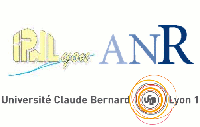Orateur
Dr
Patrick Pittet
(Institut des Nanotechnologies de Lyon)
Description
Via photoluminescence (PL) measurements, we have investigated GaN scintillator for developing dosimetric systems for external beam radiotherapy. GaN is a wide direct-gap semiconductor with interesting features of near-band-edge emission: high intensity, narrow-band, not being directly related to defects, fast and linear response.
We have used Si-doped n-type GaN substrates in this work. The samples have common dominant band-edge emission at room temperature (RT), with a strongly doping-dependence on their PL spectra. GaN with concentrations up to 1018cm-3 exhibits a non-negligible yellow luminescence (YL) or red luminescence (RL) broad band contribution, which is probably due to Ga-vacancy native defect. In contrast, heavily Si-doped n-type GaN ( 1.5x1019cm-3) has much more intense band-edge emission, with no significant contributions of lower-energy bands. Evidently, heavily-doped GaN provides much more free majority carriers to increase the band-to-band recombination rate, which consequently reduces other competing indirect recombination rates, including nonradiative ones. Therefore heavily-doped GaN is preferred to be used as scintillator for radioluminescence (RL)-based dosimetry. It gives enhanced narrow-band emission intensity allowing improvements on sensitivity of RL conversion and signal-to-noise ratio by spectral background rejection. Moreover, heavily doped GaN has reduced self-absorption effects on bulk RL emission.
At low temperature (up to 200K), the PL intensity of the used heavily doped GaN is dominated by a DBE (donor-bound exciton) line (10K D0XA at 3.467eV). When further increasing the temperature, band-to-band recombination becomes dominant with red-shift in connection with gap narrowing. The shift in peak wavelength from 10 to 300K is about 6nm, while the corresponding PL integrated intensity is decreased only by 30%.
Two samples of heavily-doped GaN are irradiated to receive a 200Gy dose with 6MV photon and 6MeV electron beams respectively. RT PL measurements on irradiated and non-irradiated samples show no noticeable spectral variations. At 10k, slight increases of dominant PL peak on the irradiated samples are observed.
An in vivo dosimetric probe employing heavily doped GaN has been designed and tested in radio-therapy conditions. The obtained results confirm that GaN scintillator is suitable for such applications.
Auteur
Dr
Patrick Pittet
(Institut des Nanotechnologies de Lyon)
Co-auteurs
M.
Anas Ismail
(CHU de Grenoble)
Prof.
Guo-Neng Lu
(Institut des Nanotechnologies de Lyon)
Prof.
Jacques Balosso
(CHU de Grenoble)
Dr
Jean-Marc Galvan
(Institut des Nanotechnologies de Lyon)
Dr
Jean-Yves Giraud
(CHU de Grenoble)

